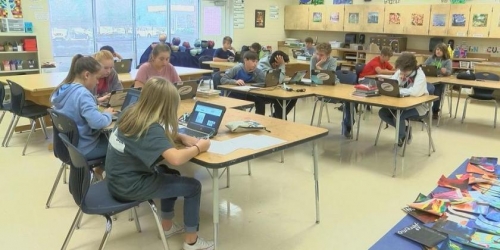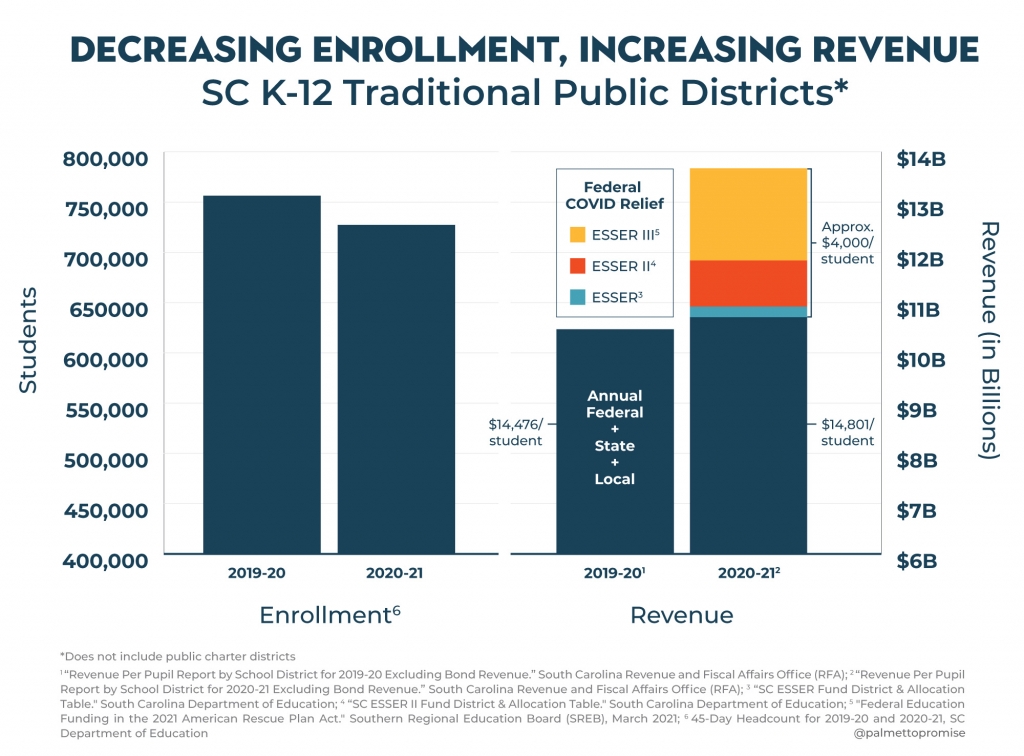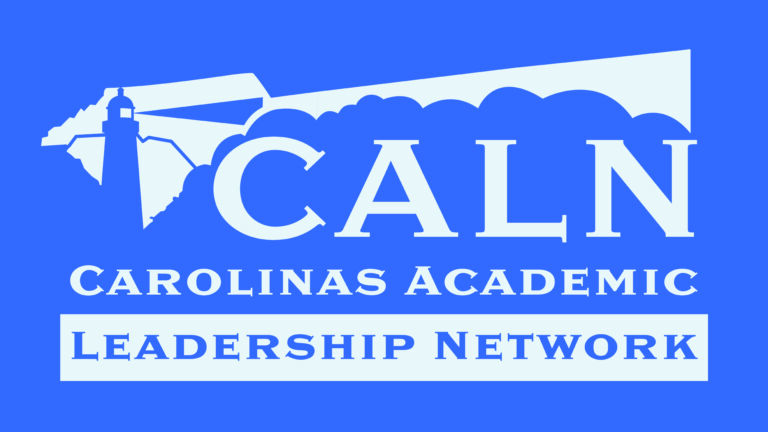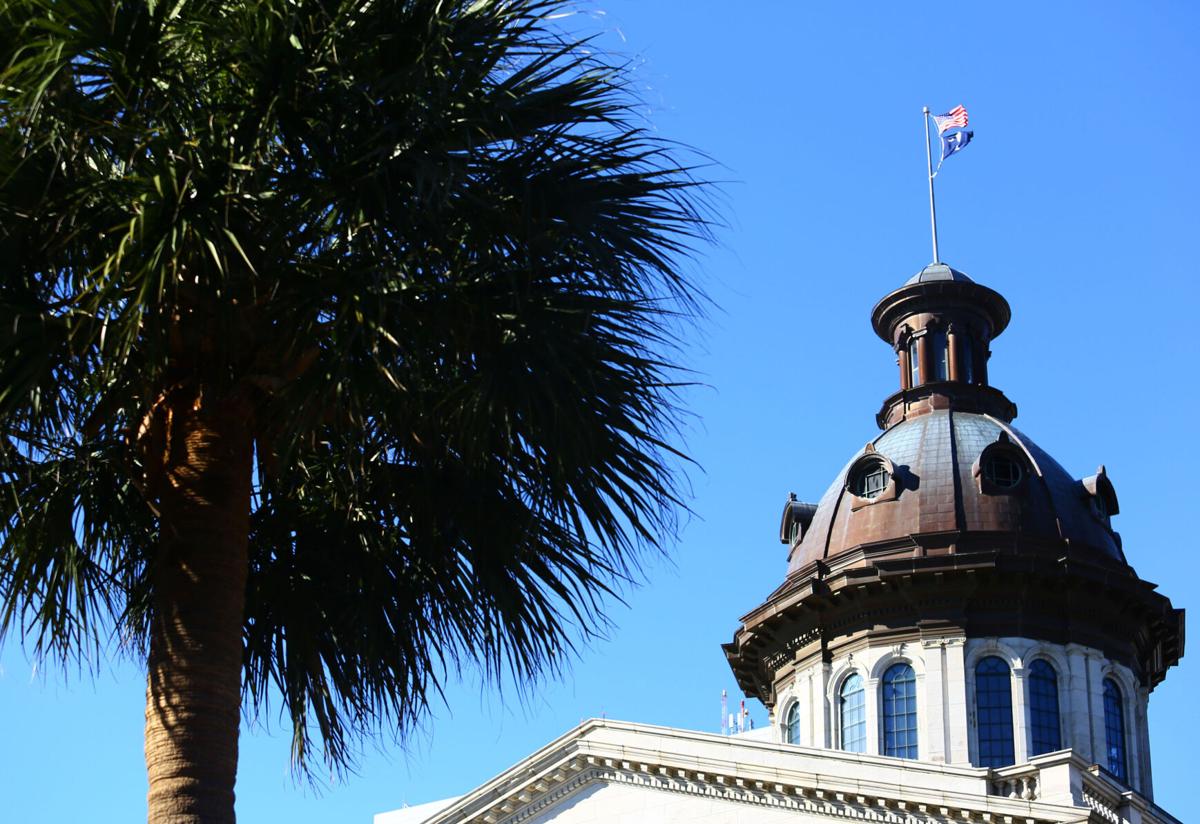K-12 education sees a tsunami of cash: what about parents?
As Palmetto Promise has previously reported, South Carolina public schools are on the receiving end of an “unprecedented” $3.4 billion in one-time pandemic-related funds.
This is on top of the estimated $10.7 billion K-12 public schools are already slated to receive this school year from annually recurring sources of federal, state, and local revenue. The state’s new budget for the 2021-22 fiscal year included over $350 million in new K-12 education spending, including line items for teacher raises, new instructional materials, rural school construction, and expanded full-day 4K among other items.
Note: enrollment figures for the 2021-22 school year have not yet been released.
Congress has also allocated an estimated $81 million in federal dollars to a program for South Carolina’s independent schools to help offset COVID-19 related expenses.
Which begs the question: what is being done to support and empower parents, the ones closest to and most invested in their students’ learning? Sadly, the answer to-date is nothing.
However, a recent set of recommendations could be a harbinger of change.
Shortly after the onset of the COVID pandemic in 2020, Governor Henry McMaster empaneled AccelerateSC, a committee of business, legislative, and community leaders tasked with making recommendations to the General Assembly for the enormous amounts of federal aid flowing into South Carolina.
AccelerateSC’s most recent report (August 24, 2021) contained several worthy provisions, dubbed by Chairman James Burns as “education enterprise initiatives,” targeted to empower parents and jumpstarting proven school innovations.
1. $50 million for supplemental education service grants to parents.
“The goal of this recommendation is to accelerate learning for students whose academic endeavors have been negatively impacted by the pandemic and to give parents a choice in the educational services needed to meet their child’s individual academic needs. … Priority would be given to the lowest performing, economically disadvantaged students.” – Accelerate SC report
During committee discussion at the July 22, 2021 meeting, Dr. Akil Ross, interim Superintendent of Lexington-Richland District 5, observed that children “are always learning,” noting that in a normal education year 79% of learning hours are spent outside of the classroom.
Clearly, the last two years have been anything but normal, with the shift to remote learning leading to even more time out of the classroom and creating significant financial strains on families. While some families had the resources to comfortably pursue different education opportunities such as hiring a tutor, transferring to a public or private school operating in-person, or participating in a learning pod, many other families felt the economic pinch…or simply went without.
According to a recent report from the American Enterprise Institute (AEI), average monthly spending on educational activities grew 10% during COVID, noting:
“Parents also made enormous sacrifices to cover these costs. Tyton’s research shows that nearly 30 percent of parents reported they had to work different hours to accommodate their child participating in supplemental services such as learning pods, and more than 20 percent said they had to reduce spending, take on additional jobs, or use savings to pay for these services.
For millions of students with disabilities and special needs, the shift to remote learning has created additional challenges and financial pressures for families that had to pay out of pocket for therapies and services often provided by schools. NPR reported how ‘modified instruction, behavioral counseling, and speech and physical therapy disappeared or were feebly reproduced online, for three, six, nine months. In some places, they have yet to fully resume.’”
The good news: South Carolina can follow the example of a number of states, including Florida, Louisiana, and Ohio, who are putting these resources directly into the hands of parents to help their children recover lost learning and accelerate to where they need to be.
AccelerateSC has recommended grants of up to $1,000 per student per school year for parents to spend on “instructional material and curriculum, tutoring services, after-school education programs, and summer education programs.” Educational therapies for students with special needs should also be included in this list of expenses, which could be efficiently and transparently administered through online technology already in use in South Carolina.
These funds could enable parents to make customized and immediate impact in the education journey of thousands of Palmetto State students. As Dr. Ross stated, “As much flexibility and choice as a parent has, I think, the better.” AEI report author John Bailey summed it up well:
“The federal government has trusted low-income families to spend other direct cash assistance for their own best interests. State and local governments should also trust them to spend an education recovery benefit for their children’s best interests.”
2. $15 million to facilitate the creation of “schools of innovation,” especially in rural communities.
The General Assembly recently enacted a law allowing traditional public school districts to create multiple “schools of innovation,” building on the success modeled by Meeting Street Schools in Charleston and Spartanburg. This recommendation would provide “seed money” to allow school boards to decide to allow schools in their districts more operational flexibility in how they train and retain high-quality teachers, as well as invest in high quality curriculum and professional development to support it over the long run. In committee discussions, Governor McMaster noted that while many rural areas may not have a philanthropist in their own backyard, this type of seed money from the state could attract partnerships from other communities across South Carolina as well as nationally.
3. Up to $10 million for an online Educational Dashboard.
We have known for a long time that far too many children in South Carolina aren’t where they need to be educationally. COVID has only exacerbated that trend, with recent reports showing 7 in 10 elementary and middle school children behind grade level in English and Math. How will we help these children? How will we know if programs and investments are working or not?
It’s no secret that “good decisions start with good data.” Dr. Ross noted that the dashboard would help communities have a real-time scoreboard to know how their children are doing and that states like Mississippi are successfully using these types of tools to strengthen parents’ engagement and knowledge.
By harnessing existing data already collected by school districts and publicly reported to document educational attainment and growth as well as financial expenditures of state, local and federal funds, the dashboard would be a major step forward to help the state fulfill its responsibility to students, parents, and taxpayers by showing in transparent, understandable ways how money is being spent and how students across the state are progressing. (NOTE: the recommendation specifically states the dashboard would not include personal or individual student information, an important protection of privacy.)
In Conclusion
There is no doubt that COVID has significantly increased many students’ academic, social, emotional, and mental health needs. With a massive infusion of relatively flexible federal funds, South Carolina lawmakers have a once-in-a-lifetime opportunity to wisely steward these resources to support students and families who have been most dramatically impacted by school closures and lack-luster remote learning, as well as expand innovation and create unprecedented transparency.
Each of these recommendations deserves deliberate consideration when lawmakers return in January to appropriate these emergency funds.








